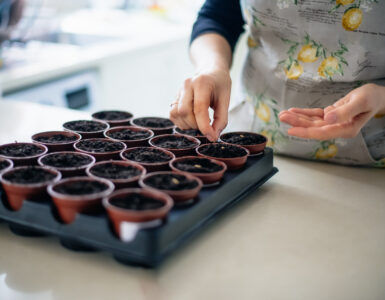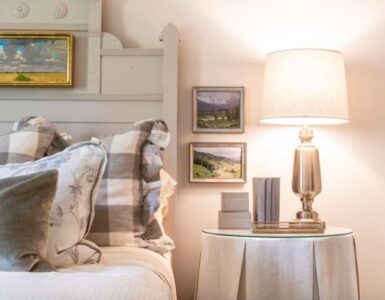Darin Engh, from Engh Gardens, explains why fruitscaping is a tasty way to landscape your yard.
Fruit-bearing trees, shrubs, and vines become permanent fixtures in the landscape, their branching patterns, their bark, and their trunks enduring throughout the year and looking more dramatic with time. Many fruiting plants are spectacular ornaments and especially so in certain seasons: Just look at peach branches studded in spring with powder puffs of pink blossoms.
If you’ve never or rarely tasted homegrown fruits, you’ve missed out on some real treats. Contrast the fruits you can buy with what you can pick in your yard. You can grow kinds and varieties of fruits that you can enjoy eating. There’s much talk nowadays about the environmental and health-related benefits of eating locally grown food; you can’t get any more local than your yard! Those luscious healthful fruits that you’ll be harvesting…well, you could be picking them from plants that are beautifying your yard, elbow to elbow with rhododendrons, Japanese maples, forsythias, roses, and other strictly ornamental plants.
How difficult is it to grow your own fruit? How much know-how do you really need? How much time and effort are involved? Some fruits are certainly easier than other. None of these fruits are hard to grow, but you are likely to have much more success, if you choose the right varieties for the growing conditions you can offer; nourish the soil and feed often.
• Prepare the soil before planting, adding plenty of organic matter if the soil is sandy or heavy. Mix some bone meal into the soil in each planting hole. Put in a short stake on the side of the prevailing wind (although this is not necessary for all trees), and make sure that the place where the rootstock and grafted stem are joined will be positioned well above ground level. Water in the tree and keep well-watered during the first year or two – drought stress is a common cause of death in young trees.
• Mulch an area of at least 3 ft in diameter around each tree with well-rotted manure, garden compost, straw, or wood chippings, but don’t let the mulch touch the trunk. Keep mulching the area, and ensure it is kept weed-free, for the first three to four years.
• Prune each winter for the first four to five years, cutting back branches to make a framework of strong, well-spaced branches. Once the tree has developed its framework, all it needs is light pruning in order to take out any dead and diseased wood or crossing branches.
• Feed with an organic fertilizer in early spring.
• Encourage natural predators – chickadees, ladybugs and lacewings will pick off aphids, while under planting with chives or garlic will help to deter them. Nectar-rich flowers, such as wildflowers, will attract pollinating insects.
Grow Your Own
• Strawberry – Strawberries thrive in pots or baskets or as groundcovers in sunny spots. Categorized as June bearing (produce one crop per year in late spring or early summer), everbearing and day-neutrals (everbearing bear one crop in early summer and one in fall, while day neutrals come to peak harvest in early summer and continue to produce fruit through fall). Strawberry plants have white or pink flowers and toothed, roundish, medium green leaves. They grow 6-8 in tall and spread by long runners to about 1 ft across. Strawberries thrive when set near painted daisy, which is well known as an insect repellent. Companion planting of strawberries with lavender is also recommended to deter birds during the fruiting season. “Old wives” say strawberry runners put forth larger fruit when borage is planted nearby.
o ‘Quinault’. Everbearing. Large, attractive berries are tasty, rather soft. Good producer of runners. Resists viruses.
o ‘Sequoia’. June bearing. One of the tastiest strawberries. Bears for many months. Resistant to alkalinity and most leaf diseases.
• Blackberry – All kinds of blackberries bear fruit in the summers, and a couple of everbearing varieties bear fruit in fall as well. For best results, amend soil generously with organic matter and provide frequent water, heavy mulch, and protection from wind. Keep down weeds and pull out suckers. Most blackberries grow vigorously and don’t demand a lot of attention. If anything, you’ll find they need taming rather than encouragement. Combine early, midseason, and late varieties to get fresh fruit over the longest possible season. Blackberries are long-lived, easy plants, and can tolerate some shade.
o ‘Navajo’ blackberry is thornless and doesn’t need a trellis.
• Blueberry – Most types grown for their fruit are also handsome plants suitable for hedges or shrub borders. Leaves, to 3 inches long, are bronze when new, maturing to dark green and turning scarlet or yellow in fall. Tiny urn-shaped spring flowers are white or pinkish. Summer fruit is decorative. Though many blueberries are fully or partially self-fruitful, grow at least two different varieties of each type for better pollination, bigger berries, and superior production, choosing kinds that ripen at different times for a long harvest. Amend soil with peat for more acidity.
o ‘Northcountry’. Early midseason. Grows 1 ½ – 3 ft tall and 2 ½ – 5 ft wide. Sweet, very light blue berries.
o ‘Northsky’. Midseason to late. Dense, to 1 -1 ½ ft tall. Light blue berries with hit of wild blueberry taste.
o ‘Northblue’. Midseason. Upright, to 4 ft tall and 5 ft wide. Large, firm, dark blue berries with trace of wild blueberry flavor.
• Gooseberry – Gooseberries are often thorny, and has leaves that usually turn bright colors before they fall. Drooping flower clusters bloom in early spring, followed in late spring or summer by fruit. Fruit is often decorative, marked with longitudinal stripes, and mostly used for pies and canning.
• Plum – Plums come in many colors—both inside and out. Skin may be yellow, red, purple, green, blue, or almost black; flesh may be yellow, red, or green. Japanese plums are the largest and juiciest of all, with a pleasant blend of acid and sugar; they are mainly eaten fresh.
o ‘Burgundy’ Self-fruitful. Small. Dark red skin and flesh. Excellent, rich flavor. Early to midseason. Great fresh or canned. Fruit holds well on tree.
o ‘Santa Rosa’ Self-fruitful. Medium to large. Purplish red skin with heavy blue bloom; yellow flesh (dark red near skin). Rich, pleasing tart flavor. Early.
o ‘Plumcot’. This was the original plum-apricot cross made by Luther Burbank. Large apricot size, round. Yellow, blushed melon red skin. Golden yellow, juicy, plum-like flesh with aromatic touch of apricot flavor. Tree form and fruit appearance favors plum parent.
• Cherries – Both sweet and sour cherries are attractive, productive trees in the home garden. Sweet cherry trees are larger and usually require a pollenizer, while sour cherries are small, more widely adapted, and self-fruitful. Most people eat sweet cherries fresh and use sour cherries in cooking; both kinds dry well.
o ‘Bing’. Top-quality, large, dark red, meaty fruit for fine flavor. #1 popular sweet cherry. Large. Dark red skin. Rich, sweet, firm, purplish flesh. Excellent for eating, canning, and preserves. Needs pollinizer such as Black Tartarian, Van, Rainier, or Stella. Ripens Early to Mid-season.
o ‘Black Tartarian’. Purplish black, firm, sweet fruit smaller than that of ‘Bing’. Good pollenizer for other cherries. Early.
o ‘Utah Giant’ Ripens with ‘Bing’ but fruit is larger and sweeter, developing sweetness even before fully ripe. Excellent flavor. Midseason.
• Apples – Apples are the world’s most widely adapted deciduous fruits. Semidwarf apples are larger than dwarfs (and bear bigger crops) but smaller than standard trees. You don’t have to own acres of land to grow your own apples. All you need is the right kind of apple tree, potting soil, and a pot. Then, as long as you remember to water and feed it, you should get showers of pretty blossoms in spring, followed by your own crop of juicy apples in the fall.
o ‘Golden Delicious’ produces fruit without a pollenizer and comes into bearing at a younger age. Clear yellow color. Aromatic, crisp. Excellent for eating fresh and cooking.
o ‘Gala’. Beautiful red-on-yellow color. Yellow flesh is highly aromatic, firm, crisp juicy, sweet.
o ‘Red Gravenstein’. Large; deep yellow skin with brilliant red stripes. Crisp, aromatic. Juicy. Excellent for fresh eating; makes applesauce with character.
o ‘Jonagold’. Yellow with heavy red striping. Firm, juicy flesh; fine mildly tart flavor. A frequent taste-test favorite.
o ‘Pink Pearl’. Medium size; pale green skin, sometimes blushed red. Sweet-tart pink flesh. Good keeper. Very attractive in bloom; blossoms deeper pink than on most other varieties.
• Peaches – Growing perfectly ripe peaches relies on good summers and a very sheltered site. For best peaches, thin fruits early, allowing 6-8 inches between each. A peach tree’s bright pink blossoms are an awesome sight in spring, all the more so because they unfold early and open against branches still bare of leaves. The glossy, lance shaped leaves unfurl later and are quite attractive all summer long as they arch downward with a look reminiscent of bamboo or of large willow leaves.
o ‘Champagne’. Medium to large. Round fruit with a light reddish blush and light pubescence. Clear white flesh with attractive red at pit. Smooth, melting texture; fine sweet flavor, well balanced. Vigorous, very productive tree.
o ‘Rubidoux’. Large. Red blushed, yellow skin. Yellow flesh, keeps well. Excellent flavor. A prolific bearer at a young age.
o ‘Dwarf Empress’ Outstanding peach due to its delicious, mouth watering, sweet flavor. Large. Pink to red skin so outstanding in color that it appears to glow. Yellow flesh, juicy. Clingstone. Outstanding pink spring blooms.
For more information, you can visit Darin at Engh Gardens in Sandy or online at www.enghgardens.com.















Add comment